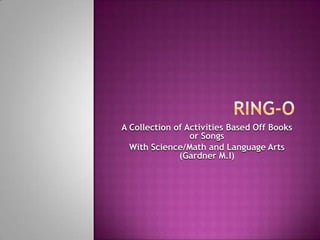
Ring o
- 1. Ring-O A Collection of Activities Based Off Books or Songs With Science/Math and Language Arts (Gardner M.I)
- 2. Part of the "Beginners Book Series", Hop on Pop is an illustrated book which rhymes words and pictures in a way that encourages children to read.
- 3. Hop on Pop Dr. Seuss Ask students to give words that rhyme. Discuss which rhyming words have the same final sound but different initial sounds. Talk about what we predict “Hop on Pop” will be about. Ask students what they think would happen if they really hopped on pop. Read “Hop on Pop”. Write rhyming words in their flip books from the story. Also write some words the students want to share on a chart at the front of the room. Students should practice circling the initial sounds of the words and underlining the final sounds on the chart at the front of the room. The students should then circle and underline accordingly in their flip chart. Sing 3 Little Monkeys jumping on the bed. Gardner’s: Linguistic Intelligence Interpersonal Intelligence English Standard- K.1.10 Say rhyming words in response to an oral prompt Math Standard- Find the number that is one more than or one less than any whole number up to 10.
- 4. = This nonsensical romp through a gallery of imaginary creatures introduces beginning readers to a variety of rhyming letter combinations. Meet the Yink, who likes to wink and drink pink ink. Or the Yop, who hops from finger top to finger top. Then there is morose Ned who doesn't like his little bed. The short anecdotal poems have just the right combination of humor and the fantastic to enrapture readers.
- 5. One Fish, Two Fish… Dr. Seuss Read “One Fish Two Fish…” Discuss how the story has a pattern of the colored fish. Use laminated colored fish to put in a basket. Each student at the center will pick up a fish from the basket and complete its order for the math pattern. The laminated fish of color, shape, and size, are used to complete the patterns indicated on a handout given by the teacher. When activity is over, talk about the different fish in the ocean using the different sized, colored, and shaped pieces. Gardner’s: Logical-Mathematical intelligence Spatial intelligence Naturalist intelligence Science Standard- K.4.2. Observe plants and animals,describing how they are alike and how they are different in the way they look and in the things they do. Language arts-K.3.3. Identify characters, settings, and important events in a story
- 6. Bartholomew & the Oobleck (1949), written and illustrated by Dr. Seuss, was a nice read. I don’t know how I never ending up reading this book, but I never did until this May. I read it to my class. We were supposed to make the oobleck but ended up running out of time. That’s okay ’cause I will make this one of my first science experiments when I return to work. I would recommend this book for children as young as 4 years old.
- 7. Bartholomew & the Oobleck Dr. Seuss The students should buddy read “Bartholomew and the Oobleck”. Students then should complete the experiment to make oobleck with older partner. Ask questions about if oobleck is a solid, liquid, or gas. Have the students determine this by using their hands to explore the oobleck. When done, discuss with students the way that the king was acting. “What emotions did he have?” “How would you of handled the situation?” “How can we learn from the kings mistake?” Describe another story that is like this story. Gardner’s :Bodily-Kinesthetic intelligence Intrapersonal intelligence Science-K.3.2- Investigate that things move in different ways such as fast, slow, etc. Literature-K.3.2 Retell familiar stories
- 8. Illustrated in full color. The Cat in the Hat tells us three zany stories-in-verse about his son, his daughter, and his great-great-grandfather.
- 9. I Can Lick 30 Tigers Today Dr. Seuss Read the story. As the story goes on, ask subtraction problems that are in the book. At end of book, let students come up with their own giant word problems in pre-determined groups. The students will trade word problems to see which group can solve the most. The winner gets 5 cooperation points in class. Gardner’s: Logical-Mathematical intelligence Math standard-K.2.3- Describe addition and subtraction situations. Language Arts-K.4.3 Write using pictures, letters, or words
- 10. A lion, a dog, and a tiger are having a contest—can they get ten apples piled up on top of their heads? You better believe it! This first counting book works as a teaching tool as well as a funny story.
- 11. 10 Apples Up On Top! Dr. Seuss Explain to students you have 10 precut apples and they must get on the apple tree. As you read the story, have the students place the apple one at a time on the giant laminated apple tree. When the story is over, and all of the apples are up, count the apples as a class. Then, sing the Spanish song of numbers 1-10 counting the apples in Spanish. Gardner’s: Musical intelligence Math standard- K.1.7 Find the number that is one more than or one less than any whole number up to 10. English- K.2.5 Identify the order of information.